Near the beginning of Paul Thomas Anderson’s Phantom Thread, fashion designer Reynolds Woodcock, a man so dickish his name has two phallic puns, is dining at a hotel in the north of England. He spies an attractive waitress, Alma, and decides to challenge her with a breakfast order that seems to go on for at least ten minutes: Welsh rabbit with a poached egg … bacon … scones, butter, cream, jam … a pot of lapsang souchong tea. And some sausages. He makes her repeat it back to him; she does it perfectly — the first indication that this is a woman who can go toe-to-toe with our irascible antihero.
Anderson cuts away before we can see the actual breakfast, but the idea of it has become one of the many memes sprung up around the film. (The note Alma leaves on the receipt — “For the hungry boy” — has proven to be the year’s most surprisingly versatile catchphrase.) And so, in the interest of taking the internet’s Phantom Thread fandom to another level, I spent my Presidents’ Day holiday attempting to recreate Reynolds’s breakfast in my own kitchen. Was I gallant enough to get through the whole thing, or would I end up on the floor?
Read on below for my account, complete with recipes for you to follow along with yourself. (I recommend turning on “Phantom Thread I” before you begin.) But remember: Whatever you’re going to cook, cook it carefully.
Part I: Preparation
Scones, butter, cream, jam
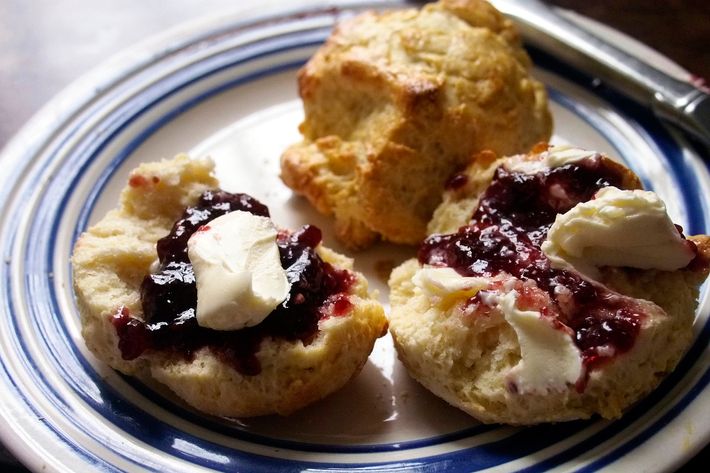
Years of watching cooking shows has drilled into me the lesson that nothing can go wrong in quite the way that baked goods can. Accordingly, I decided to use the simplest scone recipe I could find, which turned out to be the one at Curious Cuisiniere. Since I was only cooking for one, I halved all the ingredients and made four scones, which turned out to be a little depressing. If you do not want to feel like a friendless loner, I recommend making more.
Ingredients
• 1 cup flour
• 1 tablespoon sugar
• 2 teaspoons baking powder (not soda!)
• ¼ teaspoon salt
• 1.5 tablespoons butter
• ⅓ cup milk, plus 1 tablespoon
• 1 egg yolk
• Butter, jam, and clotted cream to serve
Steps
1. In a mixing bowl, combine all the dry ingredients. Cut the butter into smaller pieces and mix it in with your hands. Some recipes say to use a food processor for this part, but I didn’t learn this until my hands had already gotten real flour-y and if I have to do that, so should you.
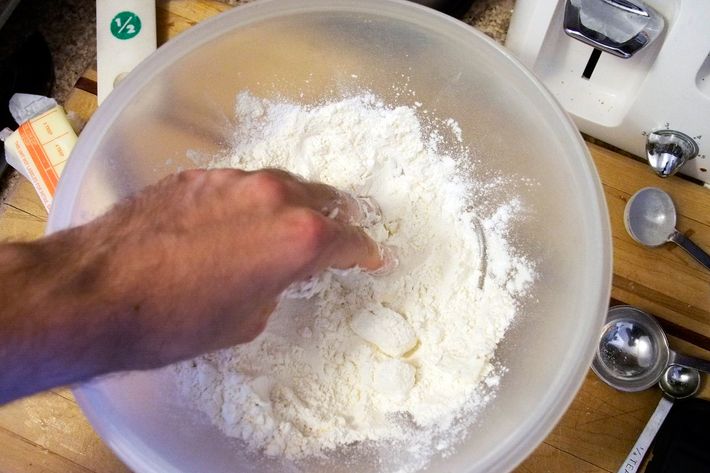
2. Once the butter has been fully mixed and there are no lumps, add the ⅓ cup of milk, and mix until it turns into something resembling dough.
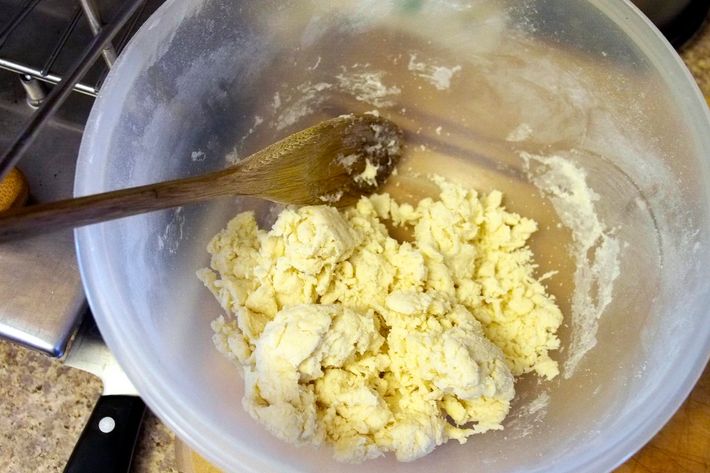
3. Spread the dough out on a flat surface until it’s around 1 inch thick. Use something round — I used a ⅓ cup measuring cup — to cut out discs about 2 inches wide.

4. Preheat the oven to 425, but let the scones rest for a bit before you put them in. This is a good time to make the tea or the sausages.
5. Mix the egg yolk with the 1 tablespoon of milk, then brush it over the scones.
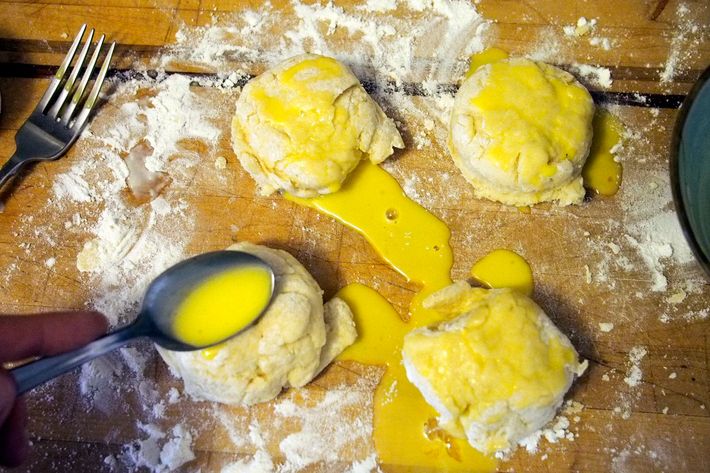
6. Put the scones on a greased baking sheet, then into the oven. Check them at 12 minutes, then go from there.
7. After the scones are done, let them chill outside the oven some more. This is a good time to make the rest of the breakfast.
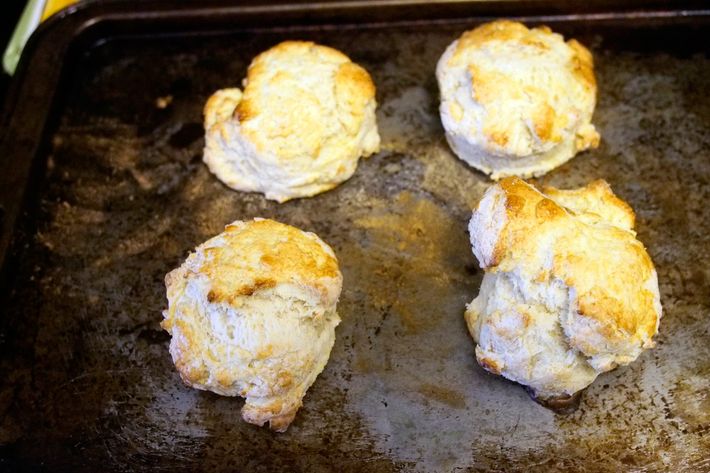
8. When it’s time to serve, break open the scones and top with buttery, jammy, creamy goodness. You can find clotted cream at fancy grocery stores like Whole Foods, or if you’re really up for a challenge you can make it yourself. (I took the lazy way out and bought some.)
A pot of lapsang souchong tea
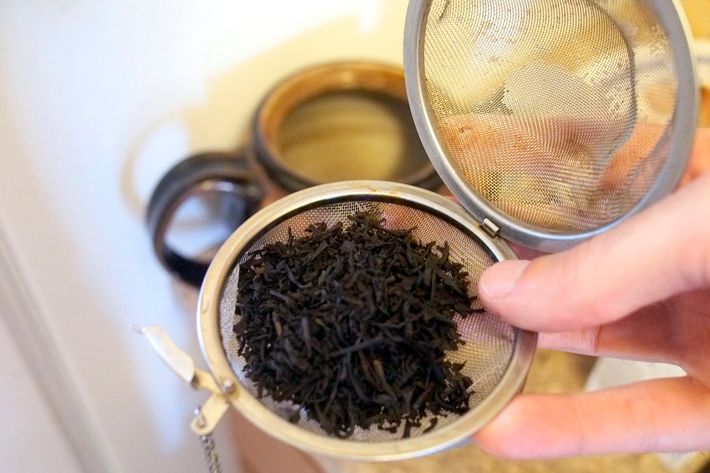
Lapsang souchong is a smoked tea from China that’s a little bit higher-end than your usual Earl Greys and English breakfasts. (Only the best for our Reynolds.) I picked up some loose-leaf at McNulty’s Tea and Coffee Shop in the West Village, but if you’re not in New York Twinings sells boxes of teabags. The instructions I found online recommended using a gaiwan, but I had fine results using my normal teapot and infuser. Anyway, you probably don’t need me to tell you how to make tea, but here’s a recipe for completeness’s sake:
Ingredients
• 2 tablespoons lapsang souchong tea leaves
Steps
1. Boil a lot of water in a kettle.
2. Put the tea leaves in a metal tea infuser.
3. Put the infuser in your teapot, then pour in the boiling water.
4. Brew until the tea is your preferred strength (around 10 minutes for me). I’m not sure if it’s gauche to add milk, but I did and it was good.
Bacon and sausages
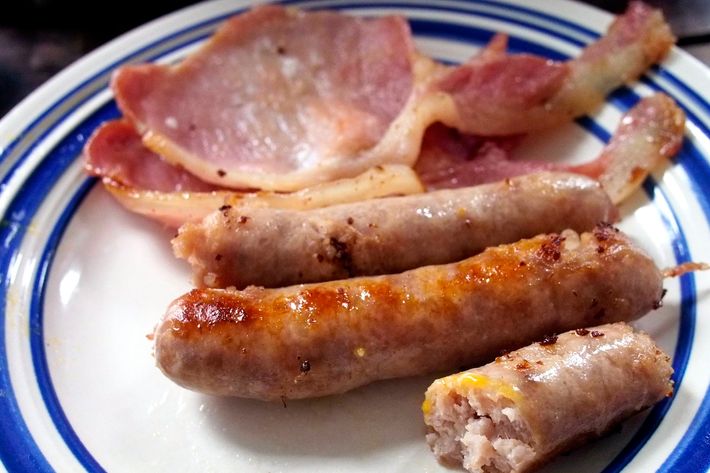
In order to get the full Phantom Thread experience, I used British-style bacon and sausages from Myers of Keswick. (I was peer-pressured into buying half a pound of Chipolata after the woman at the counter seemed skeptical of my quarter-pound order: “That’s like three sausages.”) Many people on the internet have very strong preferences about which kind of bacon is best, but I’ve never really been a bacon connoisseur, so you do you. As for the sausages, my standards are pretty low: Thanks to a family tradition of beach barbecuing, all the real British sausages I’ve eaten have always had sand in them.
Just like the tea, do you really need instructions on how to cook sausages? Apparently I did. They came linked, and when I lazily tried to break them apart with my hands, one slipped out of its condomlike skin. It quickly came apart in the frying pan, leaving the remaining sausages covered in the charred remains of their former comrade.
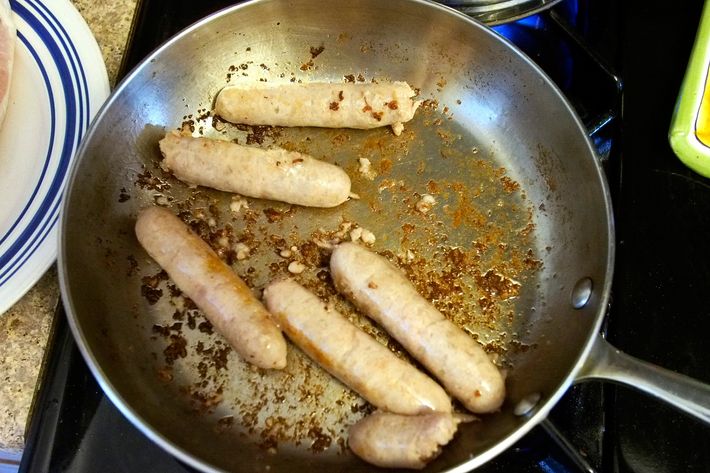
Ingredients
• As many sausage links as you want
• As much bacon as you want
• Oil or butter
Steps
1. Heat the oil or butter in a frying pan over medium heat. (The Sun recommends using butter, which is perhaps the best reason to use oil.)
2. After CAREFULLY SEPARATING the sausages, cook them until they’re brown and crispy.
3. Remove the sausages and add the bacon, cooking until it’s the right shade of pinkish-grey, but not too tough.
Welsh rabbit with a poached egg
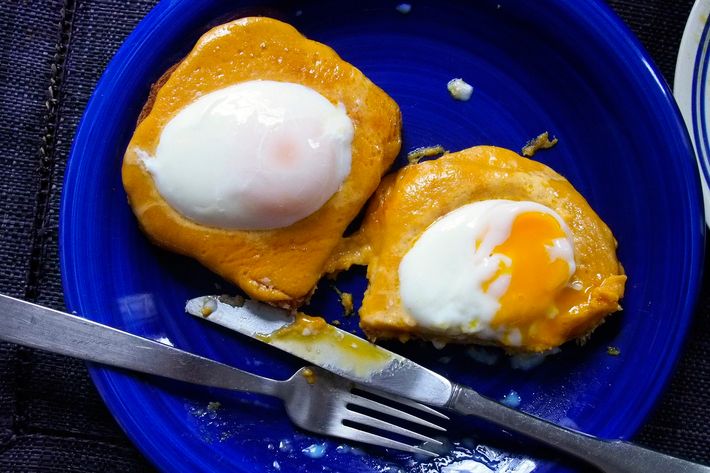
This is the big one. Two necessary disclaimers. (1) There is no rabbit in Welsh rabbit. As far as I can tell, the name seems to be a rather mean joke about Welsh people being poor, and also loving cheese. (2) “Rabbit” is the original name; “rarebit” came along later, possibly as a way to make it clear to squeamish eaters that there were no actual cottontails in the mix. (The word “rarebit” does not otherwise appear in the English language.)
Like eggs Benedict there are countless local variations of the dish, and in the process of writing this article I discovered the existence of something called a “Yorkshire rabbit,” which is a Welsh rabbit with poached egg and bacon on top. Since the Phantom Thread scene takes place in Yorkshire, could that be what Reynolds is ordering? (“Bacon” comes right after “poached egg” in the list; most of us assume there was a period in between them, but what if it was a comma?) I learned this too late to incorporate it here, but feel free to try it out and report back to me.
To make the rabbit, I used Felicity Cloake’s recipe at The Guardian as a base, with a couple changes: Since I was going to be serving the dish with poached eggs, I decided to leave out the egg yolks. (I was also worried about running out of eggs.) I also added a bit of paprika, because that’s just the kind of crazy guy I am.
Ingredients
• 2 eggs
• 2 pieces of bread
• 1 teaspoon mustard powder
• 3 tablespoons Guinness or any other dark beer
• 2 tablespoons butter
• 6 ounces grated Cheddar cheese (about ⅔ of a block). If you feel like going fancy, spring for a crumbly English cheese like Lancashire or Gloucester.
• 1 teaspoon Worcestershire sauce
• Paprika, to taste
Steps
1. You’re going to have to poach the eggs at some point, so you might as well get it over with. I used J. Kenji López-Alt’s recipe, which involves swirling your freshest eggs in a fine mesh strainer, then gently plopping them into some barely simmering water. He says 3 minutes, but I played it safe with the heat — my water was only slightly steaming — and left them in there for around 6 minutes each. Remove once the whites have solidified around the yolk; you can leave them in a bowl of ice water while you make the Welsh rabbit.
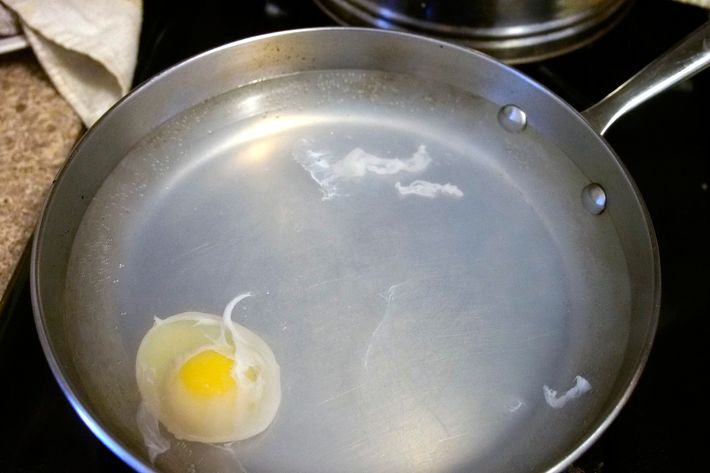
2. In the broiler, lightly toast the bread on one side. This will help it stand up to the piles of gooey cheese you’re about to heap onto it.
3. In a saucepan over medium-low heat, mix the mustard powder with the Guinness until it turns into an unappetizing brown paste.
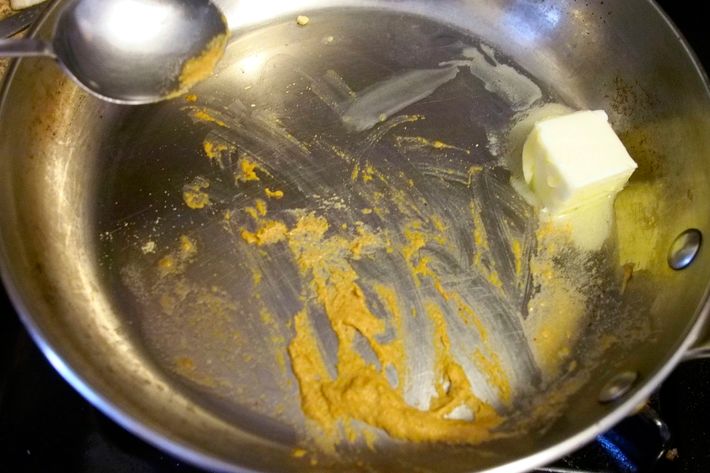
4. Add the butter, Worcestershire sauce, and paprika. Stir until it’s all melted.
5. Add the cheese. It’s maybe better to do it all in batches, but I accidentally dropped it all it once and it turned out fine, so who knows. Heat and stir until the clumpy yellow vomit-looking thing in the pan turns into a beautiful golden cheese sauce.
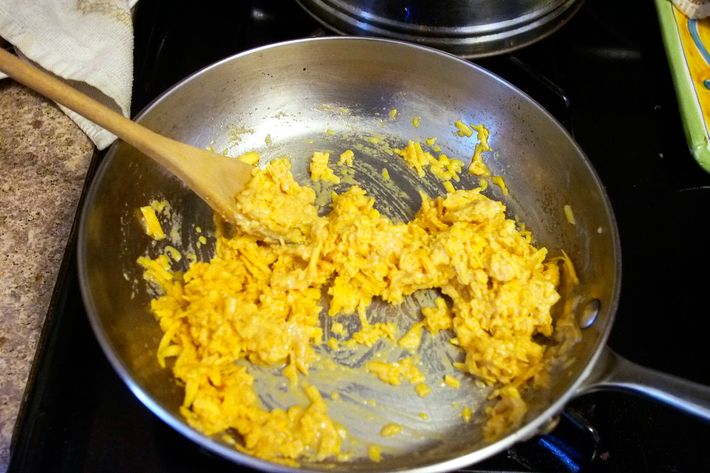
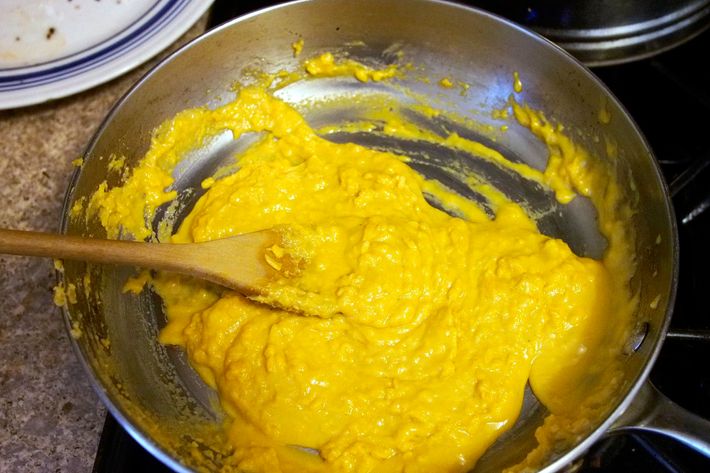
6. Flip the toast over and put it on a baking sheet. Spoon the sauce onto the untoasted side of the bread. Go crazy with it. In a perfect world, the cheese will overflow the sides of the bread like delicious, gooey lava.
7. Turn the broiler on high and toast at least until the cheese starts to bubble. After that, it’s up to you.

8. Serve with a poached egg on top of each slice of toast.
Part II: Ingestion
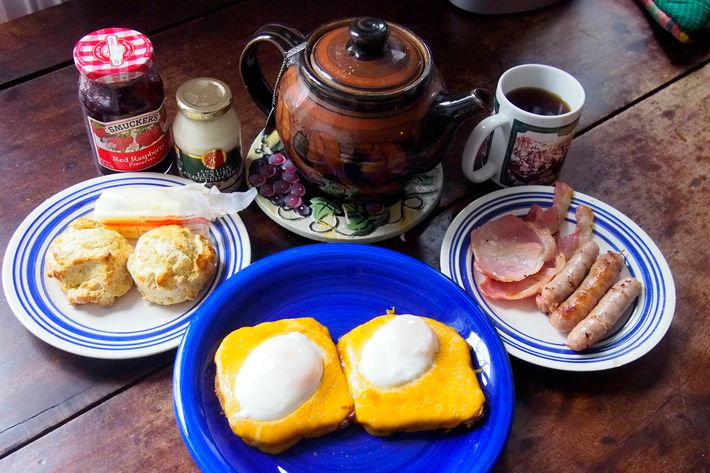
Though being Alma was a long and messy process, I got through it with my dignity intact. But was I cut out to be Reynolds, the hungry boy? Laid out before me was a breakfast feast: Three courses, each very filling on their own. I went for a run beforehand to try to work up an appetite, but to no avail — the prospect of filling my stomach with all this food was filling my stomach with dread.
My first bite was the Welsh rabbit. It was the right choice. Is there any food experience as satisfying as slicing into a poached egg? I’ve messed up the poaching process too many times to count, but this time, the eggs were near perfect. My nerves were calmed, and I allowed myself to float away on a river of golden viscosity — cheese and yolks, becoming one.
The meats were … fine. Sausages could have used a little more char, but both they and the bacon did their job. Did I need to keep eating them? No. Did I want to keep eating them? Yes.
I realized I had forgotten the scones. The mistake was soon corrected. They were humble and unshowy, a supporting player that allowed the jam and cream to shine. I tried to save the final bite for them — a little private dessert.
The tea was good, not least because drinking it gave me a few seconds’ break from shoving food in my mouth.
All together, they formed a breakfast that was almost impossibly decadent, which is of course the point. This is a meal of carbs, dairy, more carbs, and grease. There wasn’t a vegetable in sight. Around the halfway point, I started to slow down. The problem, it turned out, was the Welsh rabbit. Lacking any knowledge of the dish, I had passed over the recommended serving size of one piece of toast, and had set out to conquer two. In the end, they conquered me. I got roughly 80 percent through the breakfast before I had to tap out. I tried to reassure myself: I coulda finished it, if not for that second slice. Was this the truth, or was it the rationalizations of a weakling? I may never know.
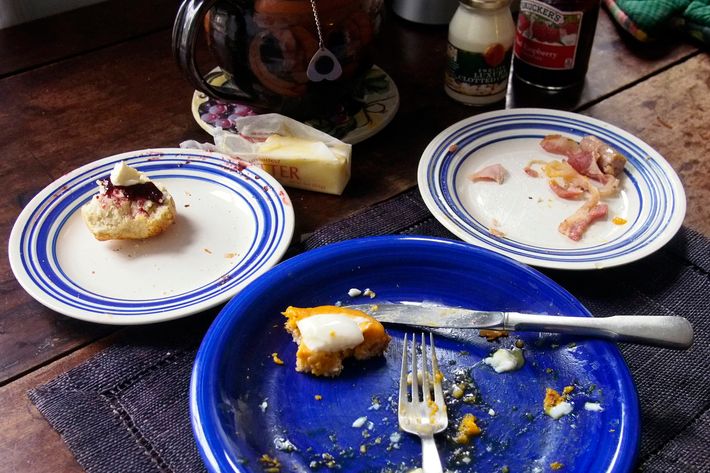
After taking a half-hour break to chill, digest, and listen to a podcast, I returned to the breakfast table and finished the meal out of stubborn determination. I was sweating, and my stomach felt like a bag of cement. I went for a six-mile walk, after which my stomach felt like a slightly smaller bag of cement. On the bright side, I finally had Reynolds Woodcock’s ideal shape — he loves a little belly.